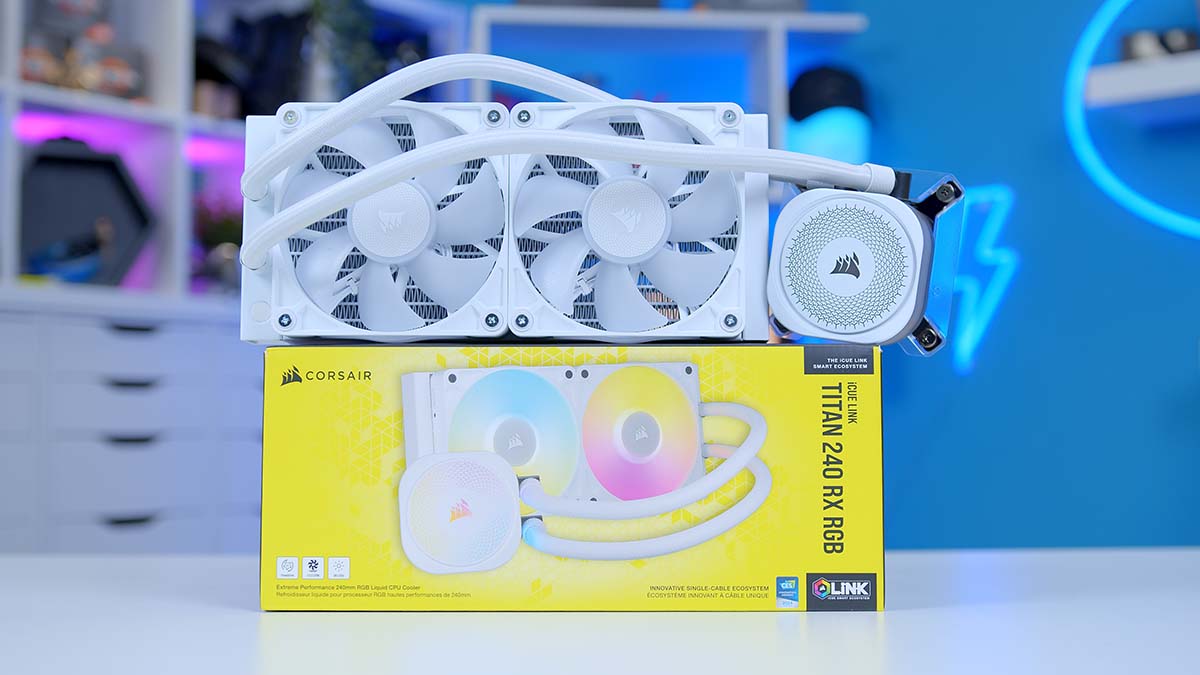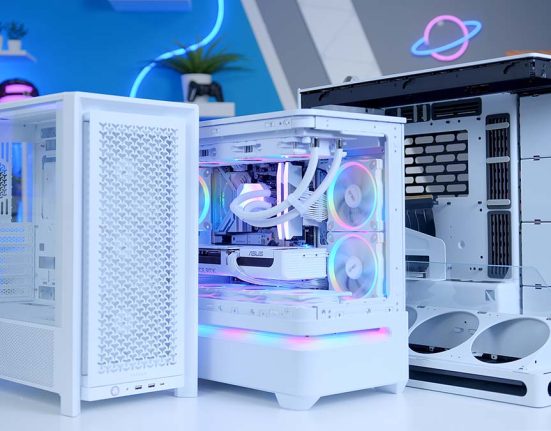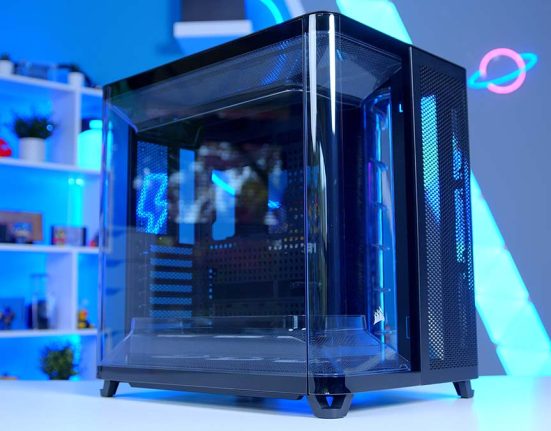The Corsair iCUE LINK TITAN 240 RX arrived on the scene in August of 2024, marking a major redesign to Corsair’s range of liquid AIO (all-in-one) coolers. Not only is the iCUE LINK TITAN 240 RX designed to beat out the competition by a significant margin, but these coolers are also much cheaper than the original iCUE LINK series. This makes the iCUE LINK TITAN 240 RX more competitive than previous coolers. To determine how the iCUE LINK TITAN 240 RX performs, we’ve rigorously tested this AIO in a series of synthetic benchmarks, comparing it to other liquid coolers we’ve benchmarked and reviewed.
Corsair’s 360mm iCUE LINK TITAN is a liquid CPU cooler we were pretty impressed with in our review. While pricier than some market alternatives, its performance is considerably better than the older iCUE LINK range. It’ll be interesting to see where the iCUE LINK TITAN 240 RX aligns with other 240mm AIOs like the Cooler Master 240 Atmos or DeepCool LS520.
In this review, we’ve examined the iCUE LINK TITAN 240 RX to see if it can handle the intense temperatures of the Core i7-14700K. This CPU cooler review also delves into its specs, design, build quality, installation process, and features.
Buy the Corsair iCUE LINK TITAN 240 RX on:
Specification
The specs of the iCUE LINK TITAN 240 RX and 360 RX are almost the same. The only significant difference is that the 240mm radiator is smaller and measures 277mm long instead of 396mm, as seen on the 360mm version.
The iCUE LINK TITAN 240 RX uses two 120mm RX120 RGB fans. These fans use a magnetic dome fan bearing built to provide plenty of longevity while remaining quiet even when the RPM is maxed out.

The main components connect to the iCUE LINK hub using Corsair’s proprietary iCUE LINK cables, which channel data and power. The hub provides a tach connector for the ‘CPU_FAN’ header on your motherboard, a USB header for data control, and a PCI-E 6-pin header for power. This is standard across all iCUE LINK parts, but larger coolers may require more cables or the addition of a splitter.
| Key Specs | Corsair iCUE LINK TITAN 240 RX |
|---|---|
| Radiator Size | 240mm |
| Radiator Dimensions (L x W x H) | 277mm x 120mm x 27mm |
| Number of Fans | 2 |
| Max Fan Speed | 2100RPM |
| Bearing Type | Magnetic Dome |
| Pump Connector | iCUE LINK |
| Socket Compatibility | Intel – LGA 1851, LGA 1700 AMD – AM5, AM4 |
Socket support is solid, with the iCUE LINK TITAN 240 RX accommodating AM5, AM4, and LGA 1700. One of the more notable inclusions is that the TITAN 240 RX also supports LGA 1851, which is rumoured to be Intel’s upcoming 15th-Gen socket. While these CPUs aren’t out yet, this provides some upgrading options for those planning to pick up the newest Intel processors.
Pricing is the most significant point of contention for us. At $159.99, the iCUE LINK TITAN 240 RX is close to the Cooler Master 240 Atmos and and 360mm options, like be quiet! Silent Loop 360mm and Montech HyperFlow ARGB 360. At this price, it’s difficult to wholeheartedly recommend the iCUE LINK TITAN 240 RX purely because there are cheaper 360mm AIOs out there. However, the iCUE LINK TITAN 240 RX isn’t priced poorly for those needing something more compact.
Corsair iCUE LINK TITAN 240 RX Design
Aesthetically, the iCUE LINK TITAN 240 RX is a premium but minimalist liquid CPU cooler. Like its 360mm sibling, the two iCUE LINK RX120 RGB fans are pre-installed, making the building process much more streamlined.

The entire cooler is white, apart from the screws, which are a silver colour. It’s great to see that the white colouring persists throughout, but again, the attention to detail on the screws is a slight shame.
The pump cap on the CPU blockhead is the more exciting area to note. The pump cap is interchangeable with other designs Corsair offers on its website. The ridged cap, for example, provides a slight design difference that looks great with the RGB shining through it. Alternatively, those planning to overclock should consider the VRM pump cap, which funnels air to the VRMs on your motherboard.

Overall, I like the pump cap design, but the magnetic cover that comes with the cooler is finicky. The magnet wasn’t strong enough to keep the cover on during the building process, so I removed it and placed it back once everything was secure.
Of course, the RGB lighting looks excellent. Corsair has constantly refined its RGB components over the years, and the iCUE LINK TITAN range showcases this very well. The fans and CPU blockhead can be synced up with relative ease, and there is a range of patterns and colours to choose from within the iCUE LINK software.

There aren’t any significant design differences between the 360mm and 240mm versions of the iCUE LINK TITAN RX cooler. However, these AIOs are designed well across both variants. They look and feel well-constructed and provide a sophisticated aesthetic for any PC build.
Installation Process
Regarding the installation process, both the 240mm and 360mm coolers are installed similarly. There are no deviances in the installation, bar the fact that the 240mm cooler is smaller; otherwise, all parts and mounting hardware remain the same. For this reason, we’ve kept this section pretty small. We recommend checking out our full review of the iCUE LINK TITAN 360 RX or our build article, which features the complete assembly process inside the Corsair 3500X ARGB case.
First, remove the cooler from the box and the top panel of your chosen case to make the mounting rails accessible. The fans are already pre-installed on the radiator, so we can skip the installation step entirely. Push the radiator up to the top of the case, and use the screws to secure it in place.

Add the correct mounting hardware to the motherboard. For AMD, two brackets need to be placed on the CPU blockhead. For Intel builds, attach the LGA1700 backplate to the motherboard. The LGA1700 mounting bracket comes pre-installed, so Intel users won’t need to take this off.

Place the CPU blockhead onto the CPU and secure it to the threads on the motherboard. Torque the screws in a star pattern to apply even pressure to the corners around the socket.

In terms of cabling, this cooler requires three of the iCUE LINK cables, the tach cable, which wires up to ‘CPU_FAN’ on the motherboard, the USB 2.0/Micro USB cable, and the 6-pin PCI-E power cable, which connects to your power supply.
Attach all of these to their respective places. Again, we recommend reading the iCUE LINK TITAN 360 RX review for a full deep dive into the cabling, as iCUE LINK can be a bit convoluted for those who haven’t used it before. Once the build is powered up, the fans, pump, and RGB will immediately fire up.

Corsair iCUE LINK TITAN 240 RX Performance
Every CPU cooler we review is thoroughly tested within builds and a series of synthetic benchmarks. This provides performance data for each cooler, showing how it copes with gaming and multi-core workloads. Our benchmarking system has an Intel Core i7-14700K at its core, with four 140mm fans to maximise airflow. Each cooler is set to ‘Turbo’ mode in the BIOS, or we use an equivalent fan curve with the cooler’s software so that testing is fair. All the data we collect is gathered from benchmarks in Cinebench and CPU-Z with HWMonitor running in the background to record temperature information.
Cinebench
In Cinebench, we run two different benchmarks. The first is a four-thread test, akin to a gaming workload, and the second uses eight threads, likely to be used in content creation applications. These run several times to test throttling under a sustained load, showing whether the iCUE LINK TITAN 240 RX will cope when temperatures fluctuate.
Looking at the performance of the iCUE LINK 240 RX, this is where this cooler differs compared to the 360mm version. In the four-thread Cinebench run, the TITAN 240 RX placed second compared to the other 240mm and air cooling options we’ve tested. With an average of 65°C and a maximum of 71°C, the TITAN 240 RX aligns with other solid 240mm AIOs like the Cooler Master 240 Atmos.

Ultimately, the smaller radiator compared to the 360mm variant is why performance drops. But compared to other 240mm coolers, performance is pretty solid. A single degree stops the TITAN 240 RX from taking the top spot in this graph, which is quite impressive. It’s also great to see the max and average quite close together, and it shows that the TITAN 240 RX can handle some of the considerable fluctuations that arise when playing games.
Stepping things up a notch with the eight-thread benchmark, performance remained strong here. Temperatures climbed to 74°C on average, with the maximum hovering around 83°C. This result puts the TITAN 240 RX first, beating the 240 Atmos by two degrees.

240mm coolers are generally not designed to be paired with top-end CPUs like the Core i7-14700K, but the iCUE LINK TITAN 240 RX offered strong competition here. Overall, we were happy with the performance output in this more challenging benchmark.
CPU-Z
In CPU-Z, we saw the same results from our Cinebench eight-thread run. The average temperature was 74°C, while the max hovered around 83°C. Our data from these benchmarks tends to be similar, so it’s not entirely surprising that the data matches.
CPU-Z puts a more consistent load on the CPU than Cinebench, which is an excellent way to test stability, especially when overclocking is thrown into the mix. These results put the iCUE LINK TITAN 240 RX in second place, which is a solid showing.

The iCUE LINK TITAN 240 RX performed well across all our benchmarks. However, it didn’t surpass any of the 360mm coolers, which raises questions about its value. For comparison, we’ve provided the Cinebench 4 thread run, which contains all the data from the 360mm AIOs we’ve tested.
The data below shows that the iCUE LINK TITAN 240 RX sits just above the Corsair LINK H150i LCD with an average of 65°C. Again, this performance is solid, but at $160, it’s difficult to recommend it compared to the significant range of 360mm liquid coolers.

Features We Like
Hot-Swappable Pump Cap
Like the TITAN 360 RX, the TITAN 240 RX features the same hot-swappable pump cap design, which allows builders to spice up the look of their systems easily. While these pump caps must be bought as an additional accessory, they’re well-built and worth considering for those looking for a unique design.

Pre-Installed Fans
Corsair is one of the few manufacturers providing an AIO with fans installed on the radiator. This isn’t a must-have, as installing fans is straightforward. But this attention to detail is something we love to see, as it makes building a PC quick and easy.

Features We Don’t Like
Complicated Cabling Design
While the premise of iCUE LINK is unique and built to make wiring more manageable, I don’t feel it solves the issue of wiring being too complicated. For first-time builders, iCUE LINK will likely come across as complex, and it has a range of different connectors that aren’t simple to plug in.

I can appreciate iCUE LINK as a concept, but in execution, it just adds to the stress of cable management. We’d much prefer the TITAN 240 RX to utilise universal headers, as this would minimise the amount of wires to plug in and simplify the process.
Conclusion
Corsair iCUE LINK TITAN 240 RX
Product Name: iCUE LINK TITAN 240 RX
Brand: Corsair
-
Features
-
Design
-
Performance
-
Value For Money
Summary
The Corsair iCUE LINK TITAN 240 RX is a well-designed cooler. Like its 360mm sibling, the pre-installed fans and (for the most part) simple design makes building with the TITAN 240 RX easy. It features an interchangeable pump cap cover, which offers some unique looks, and the RGB, as always with Corsair coolers, looks excellent. Performance-wise, we were impressed. As a 240mm AIO, this is one of the more thermally capable liquid coolers on the market and is worth considering based on this quality alone. However, value for money is the most significant caveat that makes it hard to recommend.
At $159.99, this isn’t what we would consider cheap. Although this price is better than some of Corsair’s older coolers, this new price isn’t affordable for some. The more poignant thing is its price compared to the rest of the market. For $40 more, the iCUE LINK TITAN 360 RX becomes available, which I’d argue offers better value. Or, if you’re not bothered about the design, a cooler like the MSI CoreLiquid E360 or Montech’s HyperFlow ARGB 360 are also incredibly strong AIOs at a much lower price. The iCUE LINK TITAN 240 RX provides solid performance for a 240mm liquid cooler and is a decent pick for those restricted by cooling space. But there are far better value options that offer better thermals or for those on a tight budget.
Pros
✅ Pre-installed fans
✅ Simple installation
✅ Hot-swappable pump caps
Cons
❌ Complicated cabling
❌ Expensive
❌ Magnetic pump cap cover



![FI_[DP056] Antec flux M + 9060XT](https://geekawhat.com/wp-content/uploads/2025/12/FI_DP056-Antec-flux-M-9060XT-551x431.jpg)

![FI_[DM78] Corsair Air 5400 + 5090 Gaming PC Build](https://geekawhat.com/wp-content/uploads/2025/11/FI_DM78-Corsair-Air-5400-5090-Gaming-PC-Build-551x431.jpg)
![FI_[DP051] Antec C5 + 5070Ti Gaming PC Build](https://geekawhat.com/wp-content/uploads/2025/11/FI_DP051-Antec-C5-5070Ti-Gaming-PC-Build-551x431.jpg)

